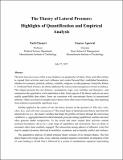The Theory of Lateral Pressure: Highlights of Quantification and Empirical Analysis
Author(s)
Choucri, Nazli
DownloadAuthor's final manuscript. (1.860Mb)
Terms of use
Metadata
Show full item recordAbstract
The term lateral pressure refers to any tendency (or propensity) of states, firms, and other entities to expand their activities and exert influence and control beyond their established boundaries, whether for economic, political, military, scientific, religious, or other purposes. Framed by Robert C. North and Nazli Choucri, the theory addresses the sources and consequences of such a tendency. This chapter presents the core features—assumptions, logic, core variables, and dynamics—and summarizes the quantitative work undertaken to date. Some aspects of the theory analysis are more readily quantifiable than others. Some are consistent with conventional theory in international relations. Others are based on insights and evidence from other areas of knowledge, thus departing from tradition in potentially significant ways.
Initially applied to the causes of war, the theory focuses on the question of: Who does what, when, how, and with what consequences? The causal logic in lateral pressure theory runs from the internal drivers (i.e., the master variables that shape the profiles of states) through the intervening variables (i.e., aggregated and articulated demands given prevailing capabilities), and the outcomes often generate added complexities. To the extent that states expand their activities outside territorial boundaries, driven by a wide range of capabilities and motivations, they are likely to encounter other states similarly engaged. The intersection among spheres of influence is the first step in complex dynamics that lead to hostilities, escalation, and eventually conflict and violence.
The quantitative analysis of lateral pressure theory consists of six distinct phases. The first phase began with a large-scale, cross- national, multiple equation econometric investigation of the 45 years leading to World War I, followed by a system of simultaneous equations representing
conflict dynamics among competing powers in the post–World War II era. The second phase is a detailed econometric analysis of Japan over the span of more than a century and two World Wars. The third phase of lateral pressure involves system dynamics modeling of growth and expansion of states from 1970s to the end of the 20th century and explores the use of fuzzy logic in this process. The fourth phase focuses on the state-based sources of anthropogenic greenhouse gases to endogenize the natural environment in the study of international relations. The fifth phase presents a detailed ontology of the driving variables shaping lateral pressure and their critical constituents in order to (a) frame their interconnections, (b) capture knowledge on sustainable development, (c) create knowledge management methods for the search, retrieval, and use of knowledge on sustainable development and (d) examine the use of visualization techniques for knowledge display and analysis. The sixth, and most recent, phase of lateral pressure theory and empirical analysis examines the new realities created by the construction of cyberspace and interactions with the traditional international order.
Date issued
2017-07-27Publisher
© Oxford University Press
Citation
Choucri, N., & Agarwal, G. (2017). The theory of lateral pressure: Highlights of quantification and empirical analysis. In W. R. Thompson (Ed.), The Oxford Encyclopedia of Empirical International Relations Theory. Oxford University Press.
Version: Author's final manuscript.
The following license files are associated with this item: